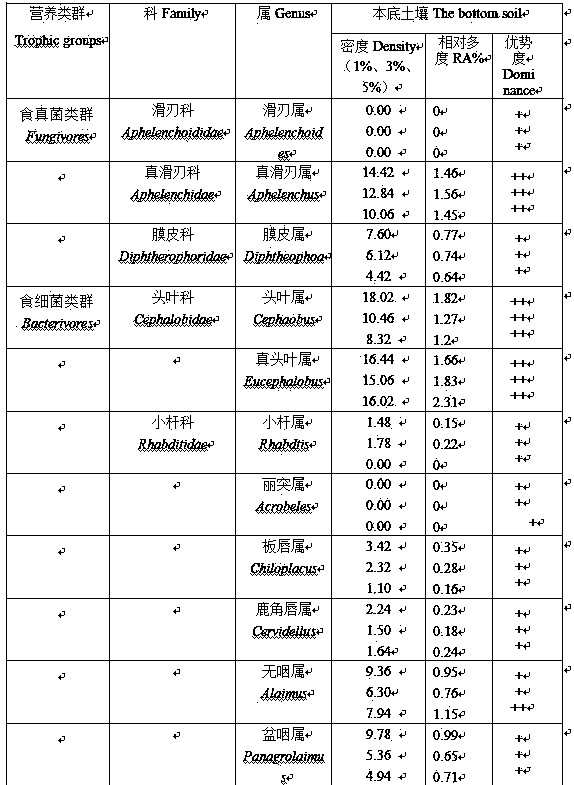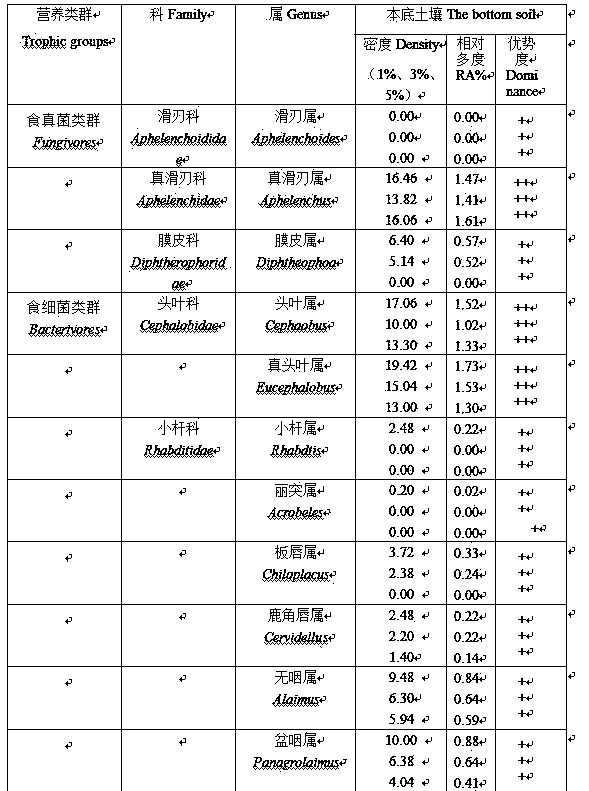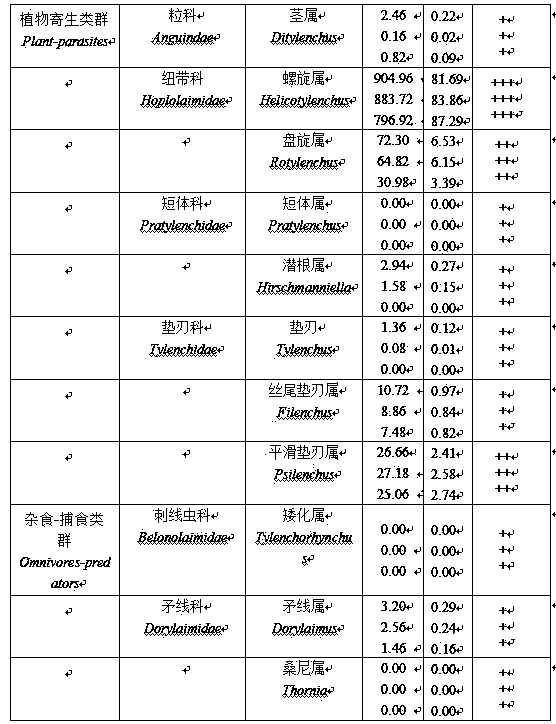Regulation and control method for improving diversity of nanocarbon to soil nematodes
A soil nematode and nano-carbon technology, applied in horticultural methods, botanical equipment and methods, horticulture, etc., can solve the problems of no significant changes, long time required for metabolism, etc.
- Summary
- Abstract
- Description
- Claims
- Application Information
AI Technical Summary
Problems solved by technology
Method used
Image
Examples
Embodiment 1
[0077] A method for regulating the diversity of soil nematodes with modified nanocarbons:
[0078] (1) Handling of materials:
[0079] The collected soil samples were passed through a 2 mm sieve and mixed for use; soil properties were: pH 7.44, organic matter content 4.68, total nitrogen 0.21%, total phosphorus 22.03 mg·kg -1 , the saturated water content is 0.58 mL g -1 , and the soil sample was passed through a 2 mm sieve and mixed for use;
[0080] Tall fescue (tall fescue) Festuca arundinacea L . );
[0081] The particle size of nanocarbon is 20 nm, and the specific surface area is 1.2×10 5 m 2 ·kg -1 , pH 7, modified before application to obtain KMnO 4 , H 2 SO 4 or HNO 3 Modified nanocarbon;
[0082] (2) Experimental method:
[0083] 1) The experiment used plastic flower pots with a height of 25 cm and a diameter of 12 cm. The gauze was washed and dried, and then cut into a circular fixed flower pot with a suitable size. Each container weighed 2 kg of ma...
Embodiment 2
[0087] A method for regulating the diversity of soil nematodes with modified nanocarbons:
[0088] (1) Handling of materials:
[0089] The collected soil samples were passed through a 2 mm sieve and mixed for use; soil properties were: pH 7.44, organic matter content 4.68, total nitrogen 0.21%, total phosphorus 22.03 mg·kg -1 , the saturated water content is 0.58 mL g -1 , and the soil sample was passed through a 2 mm sieve and mixed for use;
[0090] Tall fescue (tall fescue) Festuca arundinacea L . );
[0091] The particle size of nanocarbon is 70 nm and the specific surface area is 1.2×10 5 m 2 ·kg -1 , pH 7, modified before application to obtain KMnO 4 , H 2 SO 4 or HNO 3 Modified nanocarbon;
[0092] (2) Experimental method:
[0093] 1) The experiment used plastic flower pots with a height of 25 cm and a diameter of 12 cm. The gauze was washed and dried, and then cut into a circular fixed flower pot with a suitable size. Each container weighed 2 kg of mat...
Embodiment 3
[0098] A method for regulating the diversity of soil nematodes with modified nanocarbons:
[0099] (1) Handling of materials:
[0100] The collected soil samples were passed through a 2 mm sieve and mixed for use; soil properties were: pH 7.44, organic matter content 4.68, total nitrogen 0.21%, total phosphorus 22.03 mg·kg -1 , the saturated water content is 0.58 mL g -1 , and the soil sample was passed through a 2 mm sieve and mixed for use;
[0101] Tall fescue (tall fescue) Festuca arundinacea L . );
[0102] The particle size of nanocarbon is 50nm, and the specific surface area is 1.2×10 5 m 2 ·kg -1 , pH 7, modified before application to obtain KMnO 4 , H 2 SO 4 or HNO 3 Modified nanocarbon;
[0103] (2) Experimental method:
[0104] 1) The experiment used plastic flower pots with a height of 25 cm and a diameter of 12 cm. The gauze was washed and dried, and then cut into a circular fixed flower pot with a suitable size. Each container weighed 2 kg of mat...
PUM
 Login to View More
Login to View More Abstract
Description
Claims
Application Information
 Login to View More
Login to View More - R&D
- Intellectual Property
- Life Sciences
- Materials
- Tech Scout
- Unparalleled Data Quality
- Higher Quality Content
- 60% Fewer Hallucinations
Browse by: Latest US Patents, China's latest patents, Technical Efficacy Thesaurus, Application Domain, Technology Topic, Popular Technical Reports.
© 2025 PatSnap. All rights reserved.Legal|Privacy policy|Modern Slavery Act Transparency Statement|Sitemap|About US| Contact US: help@patsnap.com



